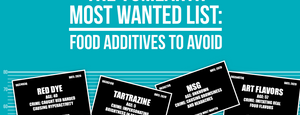
The YumEarth Most Wanted List: Additives & Ingredients to Avoid
Why Artificial Food Dyes and Artificial Flavorings Are Far From Sweet
It’s no secret...kids (and adults) love treats, especially candy. Can you blame them? Sweet, fruity, sour, gummy, YYUUUUUMMMM! Everyone deserves a bit of indulgence now and then, but it is important to understand what you are eating first. When it comes to choosing treats for kids or (yourself), there’s more to it— especially when shopping for someone with a food allergy or sensitivity.
That’s right, artificial food additives used to enhance things like color and flavor in candies and other treats, aren’t only unnecessary, but they can actually make you sick. And the crazy thing is, you can enjoy fruity, gummy, deliciously sweet-tooth satisfying candy without them. YumEarth organic candies and treats are colored with real fruit and vegetable juices, so you’ll never see things like Red Dye 40 or MSG on our labels.
Simple, real ingredients make the sweetest, best tasting candy. So the next time you hit the beat for some tasty treats, be on the lookout for the food additive most wanted list:
Red Dye 40
The most common artificial food coloring, also known as Allura Red, comes from petroleum distillates or coal tars. Yuck! Definitely one of those food dyes to avoid. People with a red dye allergy may experience hives or facial swelling.
Last Known Whereabouts: Candy, baked goods, cereal, drinks and even cosmetics
Major Offenses: Research has demonstrated a link to hyperactivity in children
Replace With: Real fruit and vegetable juices
FD&C Yellow 5 (Tartrazine)
Another artificial food dye that can produce allergic reactions in some people, including asthma and the worsening atopic dermatitis. Like other artificial food dyes, Yellow 5 is used to brighten the color of a variety of different foods.
Last Known Whereabouts: Candy, canned vegetables, cheese, ice cream, ketchup, and hot dogs
Major Offenses: Research has demonstrated a link to hyperactivity in children
Replace With: Real fruit and vegetable juices
MSG (Monosodium Glutamate)
Though found naturally, monosodium glutamate is often added to a wide variety of foods as a flavor enhancer. A true MSG allergy is rare and difficult to diagnose, however, many people do have an intolerance that can manifest in a wide range of reactions and symptoms, including numbness, headaches, facial pressure/tightness, drowsiness, and palpitations.
Last Known Whereabouts: Mostly savory foods and Chinese cuisine
Major Offenses: Nausea and intestinal discomfort, chest pain and worsened asthma symptoms
Replace With: Other natural herbs and spices
Artificial Sweeteners
Moderating the amount of sugar we eat is a concern for everyone. However, when it comes to sweet treats, we feel it’s far better to enjoy candies sweetened with real sugars every now and then versus loading up on artificial substitutes. This food additive has been suspected of causing such symptoms as headaches, seizures, and urticaria.
Last Known Whereabouts: Sugar-free foods and drinks
Major Offenses: Headaches, seizures and hives
Replace With: Real cane sugar
High Fructose Corn Syrup
Sometimes more is just more. This processed and highly concentrated sweetener is like sugar on steroids. It is often used to pack concentrated sweetness into sugary snacks and drinks, when it’s really not needed.
Last Known Whereabouts: Candies, sugary snacks, breakfast cereals, sodas and juices
Major Offenses: Linked to weight gain, type 2 diabetes and inflammation
Replace With: Real cane sugar
Artificial Flavoring
Artificial flavors are chemicals designed to mimic the taste of other ingredients and are to imitate a variety of different flavors — everything from chocolate, caramel, popcorn, fruit and more. Because these flavors come from chemicals, they have been found to produce a whole host of concerning effects.
Last Known Whereabouts: Many varieties of processed and packaged foods, including candy
Major Offenses: Linked to reduced red blood cell production and toxic effects on bone marrow cells in animals
Replace With: Fruit and vegetable juices and other naturally derived flavors
Now that you’ve been deputized to spot the bad ingredients out there, you can make smarter choices to satisfy your indulgences. And remember, when reading the ingredients list of any packaged product...if you see something that doesn’t make sense to you, or is something you’ve never heard of, it might be a suspicious food additive. Ask the questions and snack with confidence.